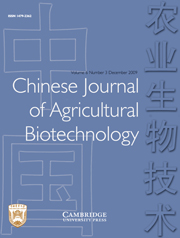Crossref Citations
This article has been cited by the following publications. This list is generated based on data provided by
Crossref.
Uzun, Aydin
Gulsen, Osman
Yesiloglu, Turgut
Aka-Kacar, Yildiz
and
Tuzcu, Onder
2010.
Distinguishing grapefruit and pummelo accessions using ISSR markers.
Czech Journal of Genetics and Plant Breeding,
Vol. 46,
Issue. 4,
p.
170.
Elcy, Goh Pik Seah
Mahani, Mansor Clyde
Park, Yong-Jin
and
Noor, Normah Mohd
2012.
Simple Sequence Repeat (SSR) profiling of cultivated Limau Madu (Citrus reticulataBlanco) in Malaysia.
Fruits,
Vol. 67,
Issue. 2,
p.
67.
Al-Sadi, A. M.
Al-Moqbali, H. S.
Al-Yahyai, R. A.
and
Al-Said, F. A.
2012.
AFLP data suggest a potential role for the low genetic diversity of acid lime (Citrus aurantifolia Swingle) in Oman in the outbreak of witches’ broom disease of lime.
Euphytica,
Vol. 188,
Issue. 2,
p.
285.
Biswas, Manosh Kumar
Chai, Lijun
Mayer, Christoph
Xu, Qiang
Guo, Wenwu
and
Deng, Xiuxin
2012.
Exploiting BAC-end sequences for the mining, characterization and utility of new short sequences repeat (SSR) markers in Citrus.
Molecular Biology Reports,
Vol. 39,
Issue. 5,
p.
5373.
Rauf, Saeed
Iqbal, Zafar
and
Shahzad, Muhammad
2013.
Genetic improvement ofCitrusfor disease resistance.
Archives Of Phytopathology And Plant Protection,
Vol. 46,
Issue. 17,
p.
2051.
Xi, Wanpeng
Fang, Bo
Zhao, Qiyang
Jiao, Bining
and
Zhou, Zhiqin
2014.
Flavonoid composition and antioxidant activities of Chinese local pummelo (Citrus grandis Osbeck.) varieties.
Food Chemistry,
Vol. 161,
Issue. ,
p.
230.
Souza Santana-Vieira, Dayse Drielly
Pereira Milori, Débora Marcondes Bastos
Villas Boas, Paulino Ribeiro
Silva, Marina França e
Santos, Magno Guimarães
Gaiotto, Fernanda Amato
Soares Filho, Walter dos Santos
and
Silva Gesteira, Abelmon da
2014.
Rapid Differentiation of Closely Related <i>Citrus Genotypes</i> by Fluorescence Spectroscopy.
Advances in Bioscience and Biotechnology,
Vol. 05,
Issue. 11,
p.
903.
Sousa, Eliana Maria Rocha
Almeida, Luciana Silva
de Oliveira Sousa, Andressa Rodrigues
de Carvalho Silva, Matheus
da Silva Ledo, Carlos Alberto
de Almeida, Alex-Alan Furtado
Cardoso Costa, Marcio Gilberto
Coelho Filho, Mauricio Antônio
Soares Filho, Walter dos Santos
and
Gesteira, Abelmon da Silva
2018.
Drought tolerance of a microcitrangemonia when treated with paclobutrazol and exposed to different water conditions.
Scientia Horticulturae,
Vol. 238,
Issue. ,
p.
75.
Almeida, Luciana Silva
Sousa, Eliana Maria Rocha
Silva, Paulo Henrique da
Oliveira, Tahise Magalhães
Almeida, Alex-Alan Furtado de
Coelho Filho, Mauricio Antônio
Soares Filho, Walter dos Santos
and
Gesteira, Abelmon da Silva
2019.
The morphological study and gene expression analysis in citrus hybrid with a short juvenile period.
Crop Breeding and Applied Biotechnology,
Vol. 19,
Issue. 3,
p.
262.
Haque, Syed Rafiul
Hossain, Md Mokter
Rahim, Md Abdur
Alam, Md Sarowar
Elhakem, Abeer
Alqurashi, Mohammed
Althaqafi, Mohammed M.
Aloufi, Salman
and
Sami, Rokayya
2022.
Characterization and the Genetic Diversity in Pummelo Using Fruit Traits and SSR Markers.
Journal of Biobased Materials and Bioenergy,
Vol. 16,
Issue. 3,
p.
459.
Gill, Komaljeet
Kumar, Pankaj
Kumar, Anshul
Kapoor, Bhuvnesh
Sharma, Rajnish
and
Joshi, Ajay Kumar
2022.
Comprehensive mechanistic insights into the citrus genetics, breeding challenges, biotechnological implications, and omics-based interventions.
Tree Genetics & Genomes,
Vol. 18,
Issue. 2,
Shi, Wenbo
Song, Weicai
Liu, Jin
Shi, Chao
and
Wang, Shuo
2023.
Comparative chloroplast genome analysis of Citrus (Rutaceae) species: Insights into genomic characterization, phylogenetic relationships, and discrimination of subgenera.
Scientia Horticulturae,
Vol. 313,
Issue. ,
p.
111909.
Abbouch, B.
Chetto, O.
Talha, A.
Selmaoui, K.
and
Benyahia, H.
2024.
Effects of storage temperature and juice pulp on the content of bioactive compounds and antioxidant activity of pomelo.
Acta Horticulturae,
p.
361.
Sidhu, Gurupkar Singh
Dhaliwal, Harkirat Singh
Gaikwad, Popat Nanaso
and
Vishal
2024.
Polyembryony and morpho-genetic characterisation of zygotic seedlings through microsatellite markers in ten polyembryonic citrus rootstocks.
Seed Science and Technology,
Vol. 52,
Issue. 1,
p.
85.
Deb, Prahlad
Das, Payel
Mukherjee, Pradipto Kumar
and
Abhishek, Kumar
2025.
Morpho-biochemical and bioactive compound diversity assessment of pomelo [Citrus grandis (L.) Osbeck] accessions under semi-arid lateritic belt of West Bengal, India.
Vegetos,


